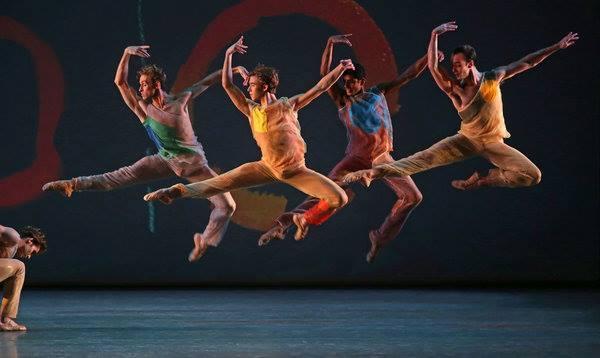A Russian troika: 19th-century composer Modest Mussorgsky, 20th-century painter Wassily Wasilyevich Kandinsky, and 21st-century choreographer Alexei Ratmansky. Add projection designer Wendall K. Harrington, lighting designer Mark Stanley, and costume designer Adeline Andre for the visually compelling Pictures At An Exhibition, which had its world premiere at New York City Ballet at a September 23rd gala that kicked off their 2014 fall season. The cast featured Sara Mearns, Tiler Peck, Abi Stafford, Wendy Whelan, Gretchen Smith, Tyler Angle, Adrian Danchig-Waring, Gonzalo Garcia, Amar Ramasar, and Joseph Gordon.
The score, Pictures At An Exhibition, is considered Mussorgsky's most famous piano composition, and was played on stage by Cameron Grant, with Ratmansky’s choreography accenting the musicality of the piece, as do Harrington’s images, which were inspired by Kandinsky’s 1913 painting “Color Study: Squares With Concentric Circles.” On an upstage screen, various sections of the painting appear and disappear, morph and transform, as the piece unfolds. Single colorful shapes on the costumes echo the geometric shapes evoked by the painting as it comes to life before our eyes.
As Harrington recalls: “Sometime last April, Alexei said ‘yes, let's use projection.’ I have made many ballets with Alexei— maybe six big ballets. He's a genius; but by August, no information, and NYCB never heard that there was to be projection, so they are in an unhappy frenzy. I offer to just design a drop, but Alexei won't hear of it.”
Finally in late August, Harrington and Ratmansky meet, and decide, as time is short, to use one image and explore it. “Just like the music does in a way,” notes Harrington. “Alexei says I always wanted to do a ballet in front of this Kandinsky study of circles and squares.” So Kandinsky it is.
As Harrington explains it, her discussion with the choreographer was brief, "’This is full company, this is solo girl, this is man and a woman…’ That’s what passes for instruction from Alexei with, of course, some conversation about where the music is heavy and light and dark.”
Harrington continues: “So assuming we can get permission to use the image and find one that is good enough to use, and given the short time span, and did I mention I’m also going to San Francisco for five days for Old Hats…so I ask Ruppert Bohle if he wants to play with me. Ruppert has essentially retired from design. He has a cushy tech job in Berlin, but he is a friend. The idea intrigues him, and he happens to have some time. Plus, the image in Munich and he is able to negotiate usage and a decent size image. Then he proceeds to take it apart brush stroke by brush stroke and we discuss what the titles of the pieces might mean— there is no dance to look at yet.
“First he starts to combine things in After Effects, but it seems like that is the road to hell; I won’t be able to work quickly enough to change things in the tiny tech time we have. So it is decided that like the work we did together in The Firebird, he will build it into Watchout files of a gazillion layers. And since I will work with Paul Vershbow as programmer (Erik Pearson did the first two days), its now a slide show. This is where Paul and I live in a way, so the combining and recombining is relatively easy to do, and in Watchout sizing and placing is so fast.
“We make some reference images to show Alexei as a sample. He is feeling positive about them and I get to see a rehearsal tape. I break down the images to the images of the dancers so I can show lighting designer Mark Stanley where we are headed, and we tech.
“Ballet tech is very fast. We never stop for lighting and projection, but we get an extra three hours (8-11am) in the theatre with light and projection and no dancers. We move things around; we change background colors; some images we thought went with one story end up with another, and the finale— Gate Of Kiev—gets a lot more cues.
“We front-project from the second ring of the Koch Theatre with a 20K Panasonic from Lars Petersen at WorldStage and, of course, Watchout. We use the company's own white plastic, not a screen, but we take what we have and are grateful, and the amazing Mark Stanley does not wash out the image,” Harrington exclaims. “I made a ballet with Mark and Alexei at La Scala last year and showed them how adding color to the image from a ground row is a good thing, and we use a lot of back light to enrich the color, to help control for the inevitable shadows, and to give a flat image shape. I think he has three locations—high, middle, and low— so we can send the color where we want and the colors he has seem infinite.

“I think we had four rehearsals with the dancers in the theatre. I film them so we can deconstruct them like a football coach after the game, and get the cueing and the shapes right. I notice the dancers looking up; I make stars; I note the violence of a duet and make the color sharp, and hard and as fast as we can.
“The last dance I did with Alexei was 59 days from the day he called to the premiere. This one was touch and go until the last two weeks, before the premiere would they get the gear, permission for the painting? But when you have the A++ team, Ruppert, Erik, Paul, and Mark Stanley, and the complete trust of the choreographer, it feels as though there is nothing you can't do or die trying to do.”
And says Harrington, “Best of all, I got to make pictures behind Wendy Whelan before she retired.”